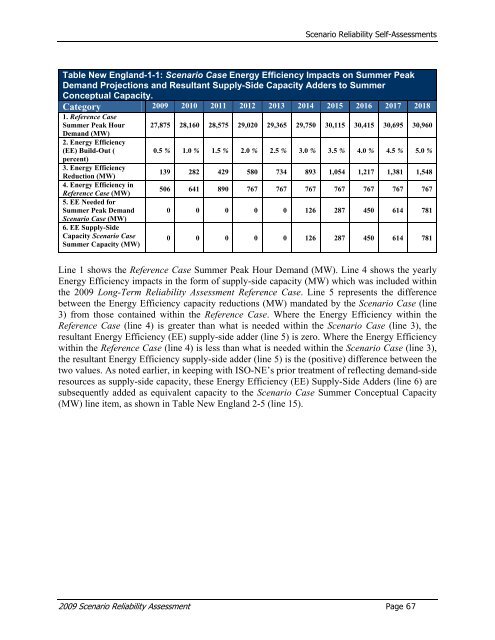2009 Scenario Reliability Assessment - NERC
2009 Scenario Reliability Assessment - NERC
2009 Scenario Reliability Assessment - NERC
- No tags were found...
You also want an ePaper? Increase the reach of your titles
YUMPU automatically turns print PDFs into web optimized ePapers that Google loves.
<strong>Scenario</strong> <strong>Reliability</strong> Self-<strong>Assessment</strong>sTable New England-1-1: <strong>Scenario</strong> Case Energy Efficiency Impacts on Summer PeakDemand Projections and Resultant Supply-Side Capacity Adders to SummerConceptual Capacity.Category <strong>2009</strong> 2010 2011 2012 2013 2014 2015 2016 2017 20181. Reference CaseSummer Peak HourDemand (MW)2. Energy Efficiency(EE) Build-Out (percent)3. Energy EfficiencyReduction (MW)4. Energy Efficiency inReference Case (MW)5. EE Needed forSummer Peak Demand<strong>Scenario</strong> Case (MW)6. EE Supply-SideCapacity <strong>Scenario</strong> CaseSummer Capacity (MW)27,875 28,160 28,575 29,020 29,365 29,750 30,115 30,415 30,695 30,9600.5 % 1.0 % 1.5 % 2.0 % 2.5 % 3.0 % 3.5 % 4.0 % 4.5 % 5.0 %139 282 429 580 734 893 1,054 1,217 1,381 1,548506 641 890 767 767 767 767 767 767 7670 0 0 0 0 126 287 450 614 7810 0 0 0 0 126 287 450 614 781Line 1 shows the Reference Case Summer Peak Hour Demand (MW). Line 4 shows the yearlyEnergy Efficiency impacts in the form of supply-side capacity (MW) which was included withinthe <strong>2009</strong> Long-Term <strong>Reliability</strong> <strong>Assessment</strong> Reference Case. Line 5 represents the differencebetween the Energy Efficiency capacity reductions (MW) mandated by the <strong>Scenario</strong> Case (line3) from those contained within the Reference Case. Where the Energy Efficiency within theReference Case (line 4) is greater than what is needed within the <strong>Scenario</strong> Case (line 3), theresultant Energy Efficiency (EE) supply-side adder (line 5) is zero. Where the Energy Efficiencywithin the Reference Case (line 4) is less than what is needed within the <strong>Scenario</strong> Case (line 3),the resultant Energy Efficiency supply-side adder (line 5) is the (positive) difference between thetwo values. As noted earlier, in keeping with ISO-NE’s prior treatment of reflecting demand-sideresources as supply-side capacity, these Energy Efficiency (EE) Supply-Side Adders (line 6) aresubsequently added as equivalent capacity to the <strong>Scenario</strong> Case Summer Conceptual Capacity(MW) line item, as shown in Table New England 2-5 (line 15).<strong>2009</strong> <strong>Scenario</strong> <strong>Reliability</strong> <strong>Assessment</strong> Page 67
















